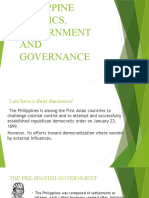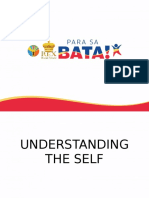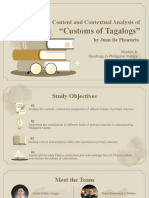The Government During The American Regime
The Government During The American Regime
Uploaded by
Sonny Magluyan FernandezCopyright:
Available Formats
The Government During The American Regime
The Government During The American Regime
Uploaded by
Sonny Magluyan FernandezOriginal Description:
Original Title
Copyright
Available Formats
Share this document
Did you find this document useful?
Is this content inappropriate?
Copyright:
Available Formats
The Government During The American Regime
The Government During The American Regime
Uploaded by
Sonny Magluyan FernandezCopyright:
Available Formats
The government during the American regime After the Spaniards capitulated to them in the Battle of Manila on August
13, 1898, the victorious Americans established the Military Government on August 14. This government which was run by military generals appointed by the American president exercised all powers of the government until the war was declared by the Americans to have ended until July 1901, following the capture of President Emilio Aguinaldo.
On July 4, 1901, upon the recommendation of the Second Philippine Commission headed by William Taft, the American authorities established the civil government that took over the functions of the military government. The president of the Philippine Commission became civil governor in areas already pacified under the American military rule. The Civil Governor (the title was later changed to Governor-General in 1905) also exercised legislative powers while remaining as president of the Philippine Commission, the lawmaking body of the government up to 1907. Upon the creation of the Philippine Assembly that served as the lower house, the Philippine Commission became the upper house of the legislative branch from 1907 to 1916. The first free national elections in the Philippines were held for the members of the Philippine Assembly who were all Filipinos where Sergio Osmea served as Speaker of the Assembly. With the passage of the Spooner Amendment in 1916, the Philippine Commission and Philippine Assembly gave way to an all Filipino Legislature. The Philippine Legislature had two houses the Senate and the House of Representatives. Manuel Quezon was elected President of the Senate and Osmea again became Speaker of the House. Despite the growing participation of the civil government there were still limitations. The American governor-general was still the power behind the government and, together with the American president could veto any law passed by the Philippine Legislature. The U.S. Congress regulated Philippine trade and the American Supreme Court could overrule the decisions of the Philippine Supreme Court. Pursuant to the provisions of the Tydings-McDuffie Law passed by the U.S. Congress, the Commonwealth Government was established to succeed American Insular Government in the Philippines. Following the first national elections under the 1935 Constitution, the Commonwealth Government was inaugurated on November 15, 1935, with Quezon as president and Osmea as vice president. The Commonwealth Government was a ten-year transitory government which gave Filipinos a chance to prove to the Americans their capability readiness in handling their own government. If proven capable the independence of the Philippines would be proclaimed upon the expiration of the said period.
The Commonwealth was a semi-independent or autonomous government of the Filipinos under American tutelage. It was republican in form under the presidential type. The legislative power was vested in a bicameral congress that was divided into the Senate and the House of Representatives. It had its own system of judicial courts with the Supreme Court on top of the ladder. When the Second World War broke out ,the Commonwealth Government became a governmentin-exile administering the affairs of the Philippines across the ocean from the United States. The Commonwealth officials, headed by President Quezon, had to flee there to the Japanese occupation of the country.
You might also like
- Philippine History & GovernmentDocument130 pagesPhilippine History & GovernmentCarlos Baul David0% (2)
- Preamble of The 1987 ConstitutionDocument1 pagePreamble of The 1987 ConstitutionJhoana ReyesNo ratings yet
- Timeline of Philippine Literature: Pre-Colonial PeriodDocument1 pageTimeline of Philippine Literature: Pre-Colonial PeriodJudith DacuaNo ratings yet
- History of Political Parties in The PhilippinesDocument9 pagesHistory of Political Parties in The PhilippinesKurt Ryan Jesura100% (1)
- Plaintiffs' Statements For The Record and Plaintiffs Request For The Court To Take Judicial NoticeDocument13 pagesPlaintiffs' Statements For The Record and Plaintiffs Request For The Court To Take Judicial NoticeJanet and James100% (1)
- Islamic Culture & CivilizationDocument2 pagesIslamic Culture & Civilizationhifza99100% (1)
- Yellow Box JunctionDocument2 pagesYellow Box Junctionmusy08No ratings yet
- Disadvantages of Cisg AssignmentDocument5 pagesDisadvantages of Cisg AssignmentKhushi Sharma100% (1)
- Evolution of Philippine Politics Government and Governance 2Document33 pagesEvolution of Philippine Politics Government and Governance 2Marc Johnlen Laigue100% (1)
- The Pre - Spanish GovernmentDocument8 pagesThe Pre - Spanish GovernmentMark Anthony Fortozo Cabulay0% (1)
- Consti 2 1973-CONSTITUTIONDocument10 pagesConsti 2 1973-CONSTITUTIONRandom internet personNo ratings yet
- History of Philippine Politics, Governments and ConstitutionsDocument94 pagesHistory of Philippine Politics, Governments and ConstitutionsAngelaNo ratings yet
- Article V: Suffrage: National Service Training Program 2 Southville International School and CollegesDocument15 pagesArticle V: Suffrage: National Service Training Program 2 Southville International School and CollegesKeaneNo ratings yet
- DocumentDocument4 pagesDocumentJames De TorresNo ratings yet
- Understanding The Self Lesson 1 4Document98 pagesUnderstanding The Self Lesson 1 4Christian DelacruzNo ratings yet
- 1986 Provisional (Freedom) Constitution of The PhilippinesDocument15 pages1986 Provisional (Freedom) Constitution of The PhilippinesChristian Wayne SalvaleonNo ratings yet
- Final Case StudyDocument6 pagesFinal Case StudyJoshua Ocariza DingdingNo ratings yet
- Biography of Prominent Filipino FiguresDocument3 pagesBiography of Prominent Filipino Figuresjovani capizNo ratings yet
- Philippine Politics and Governance: Lesson 6: Executive DepartmentDocument24 pagesPhilippine Politics and Governance: Lesson 6: Executive DepartmentAndrea IbañezNo ratings yet
- Joseph EstradaDocument20 pagesJoseph EstradasakuraleeshaoranNo ratings yet
- 7 Facts You Should Know About The Philippine FlagDocument1 page7 Facts You Should Know About The Philippine FlagAnonymous wwq9kKDY4No ratings yet
- Rights and Duties of Citizen - Main NoteDocument3 pagesRights and Duties of Citizen - Main NoteCHIZOBA DIMNo ratings yet
- Philippine HistoryDocument2 pagesPhilippine HistoryCandice Bolay-ogNo ratings yet
- NSTP Midterm Lesson 2Document26 pagesNSTP Midterm Lesson 2Reabels FranciscoNo ratings yet
- The 1899 Malolos ConstitutionDocument5 pagesThe 1899 Malolos ConstitutionShenne MinglanaNo ratings yet
- Philippine Politics and Governance: Division of BoholDocument3 pagesPhilippine Politics and Governance: Division of BoholAnabel BahintingNo ratings yet
- GE 7 Activity 3Document3 pagesGE 7 Activity 3dhave albaricoNo ratings yet
- Citizenship Training Week 4Document5 pagesCitizenship Training Week 4missmoh85100% (1)
- Story of Noynoy AquinoDocument2 pagesStory of Noynoy AquinoRENGIE GALONo ratings yet
- Lesson 10 The Tejeros ConventionDocument30 pagesLesson 10 The Tejeros ConventionMark Joseph PresasNo ratings yet
- Article Iv-CitizenshipDocument18 pagesArticle Iv-CitizenshipLizette Sy25% (4)
- 2.9. Commission On Independence, Filipino Grievances Against Governor Wood (ZAIDE, 11. PP. 230-234) - (PETITION LETTER)Document4 pages2.9. Commission On Independence, Filipino Grievances Against Governor Wood (ZAIDE, 11. PP. 230-234) - (PETITION LETTER)Zhane LabradorNo ratings yet
- Philippine Politics and Governance: Presented By: Alex A. DumandanDocument46 pagesPhilippine Politics and Governance: Presented By: Alex A. DumandanAlex Abonales DumandanNo ratings yet
- Roles and Obligations of The Philippine JudiciaryDocument49 pagesRoles and Obligations of The Philippine Judiciaryapril joy viernesNo ratings yet
- Module 4 Reading in The Philippine HistoryDocument52 pagesModule 4 Reading in The Philippine HistoryEarl Jerome BalingitNo ratings yet
- Philippine Politics and Governance Module 4Document7 pagesPhilippine Politics and Governance Module 4Rio Jaena Dimayuga67% (3)
- Historical Development of Philippine Democratic PoliticsDocument40 pagesHistorical Development of Philippine Democratic PoliticsClaudette Nicole Gardoce0% (1)
- ClintDocument3 pagesClintMary Jane SaladinoNo ratings yet
- Historical Background of The Philippine Democratic PoliticsDocument7 pagesHistorical Background of The Philippine Democratic PoliticsJonathan Pigao CacabelosNo ratings yet
- The Legislative: Reported By: Group 3Document42 pagesThe Legislative: Reported By: Group 3Hpesoj SemlapNo ratings yet
- Voters EducationDocument26 pagesVoters EducationRaymart GonzagaNo ratings yet
- Philippine AssemblyDocument3 pagesPhilippine AssemblyJerome EncinaresNo ratings yet
- Concept MapDocument1 pageConcept MapMitchieQue Chinita75% (4)
- The Philippine Commonwealth PeriodDocument18 pagesThe Philippine Commonwealth PeriodZanjo Seco0% (1)
- Carlos Modesto Villaluz "Botong" FranciscoDocument9 pagesCarlos Modesto Villaluz "Botong" Franciscovamps sierNo ratings yet
- Point of View of Spaniards: April 27, 1521Document5 pagesPoint of View of Spaniards: April 27, 1521Padingil,Ruth M.No ratings yet
- City College of Tagaytay: Republic of The PhilippinesDocument9 pagesCity College of Tagaytay: Republic of The PhilippinesJeff Jeremiah PereaNo ratings yet
- Module10-Politics Q2Document14 pagesModule10-Politics Q2Jelai MedinaNo ratings yet
- Politics and Governance With Philippine ConstitutionDocument43 pagesPolitics and Governance With Philippine ConstitutionJoan PabloNo ratings yet
- Understanding The Self Module 1 Lesson 2Document10 pagesUnderstanding The Self Module 1 Lesson 2MASHNo ratings yet
- Executive DepartmentDocument29 pagesExecutive DepartmentJdeen FajardoNo ratings yet
- Presidents of The Philippines and Their AchievementsDocument9 pagesPresidents of The Philippines and Their AchievementsVash Gaming100% (1)
- GarioDocument3 pagesGarioRoderick B. SumalloNo ratings yet
- Political Engagement and Youth EmpowermentDocument6 pagesPolitical Engagement and Youth EmpowermentAnonymous HILhsiMZ100% (1)
- Early Philippine Society and CultureDocument1 pageEarly Philippine Society and CultureClarisse EsmoresNo ratings yet
- Lesson 7 - Functions of Executive BranchDocument34 pagesLesson 7 - Functions of Executive BranchLeah Joy Valeriano-QuiñosNo ratings yet
- Anti Dynasty Bill Position PaperDocument2 pagesAnti Dynasty Bill Position PaperJOHN LLOYD OPIDONo ratings yet
- Poligov Prelims 15 16 2nd SemDocument3 pagesPoligov Prelims 15 16 2nd SemHyman Jay BlancoNo ratings yet
- 1935 CONSTITUTION - Dacumos and ValdezDocument20 pages1935 CONSTITUTION - Dacumos and ValdezBJ AmbatNo ratings yet
- Globalization - BROADER, MORE RECENT CHANGESDocument2 pagesGlobalization - BROADER, MORE RECENT CHANGESChilton John DuatNo ratings yet
- Module Samal 1Document56 pagesModule Samal 1Elsie Joy LicarteNo ratings yet
- Chapter 7 World HXDocument10 pagesChapter 7 World HXJela Valencia100% (1)
- Chapter 3Document11 pagesChapter 3Lizza PerezNo ratings yet
- Politics and Governance PPT 2Document31 pagesPolitics and Governance PPT 2jmae9347No ratings yet
- J. Crew v. Wal-Mart ComplaintDocument21 pagesJ. Crew v. Wal-Mart ComplaintTerry HartNo ratings yet
- Job Application Form For Recruitment Against of Class-IV (BPS-01 To 04) Vacant in Special Security Unit (SSU) Sindh Police (3746-54)Document3 pagesJob Application Form For Recruitment Against of Class-IV (BPS-01 To 04) Vacant in Special Security Unit (SSU) Sindh Police (3746-54)KhalidNo ratings yet
- PE - Clients - Duties & ResponsibilitiesDocument6 pagesPE - Clients - Duties & ResponsibilitiesNursara RosliNo ratings yet
- G.R. No. 182648 June 17, 2015 Herman MEDINA, Petitioner, People of The Philippines, RespondentDocument28 pagesG.R. No. 182648 June 17, 2015 Herman MEDINA, Petitioner, People of The Philippines, RespondentNicole Ann Delos ReyesNo ratings yet
- Angelos Commutation Support Letter PDFDocument16 pagesAngelos Commutation Support Letter PDFThe Salt Lake TribuneNo ratings yet
- LBC vs. PALCODocument26 pagesLBC vs. PALCOMaVictoria AytonaNo ratings yet
- Midterm and Final Exam Ed. 102Document8 pagesMidterm and Final Exam Ed. 102Marfe MontelibanoNo ratings yet
- Session 6 UndigestedDocument11 pagesSession 6 UndigestedAlfred GarciaNo ratings yet
- BOL MapclorakDocument2 pagesBOL MapclorakAbdullah LimonNo ratings yet
- Piercing The Veil of Corporate Fiction Buenaflor Umali vs. CaDocument15 pagesPiercing The Veil of Corporate Fiction Buenaflor Umali vs. CaGabe BedanaNo ratings yet
- Tcertification Info Sheet - INTDocument2 pagesTcertification Info Sheet - INTwonee1028No ratings yet
- AP Govt. Multiple Choice Question BankDocument40 pagesAP Govt. Multiple Choice Question BankKavita KrishnamorthiNo ratings yet
- Donation ExtrajudicialDocument10 pagesDonation ExtrajudicialAlyssa Clarizze Malaluan0% (1)
- Manatok v. CLTDocument14 pagesManatok v. CLTerikha_aranetaNo ratings yet
- Audit of Public ProcurementDocument13 pagesAudit of Public ProcurementHillary MageroNo ratings yet
- Rural Bank of Lipa Vs CADocument5 pagesRural Bank of Lipa Vs CAJunery BagunasNo ratings yet
- Gutierrez V DBMDocument5 pagesGutierrez V DBMWilfredNo ratings yet
- Complaint Affidavit Libel NO JUDI AFFIDocument3 pagesComplaint Affidavit Libel NO JUDI AFFIJuris MendozaNo ratings yet
- Summary Report: Royal Security Agency IncDocument3 pagesSummary Report: Royal Security Agency IncRaymund NamocaNo ratings yet
- Notice For GoodsDocument2 pagesNotice For GoodsSalim AbdulrahimNo ratings yet
- The Constitutional Ban On Land Acquisition by Aliens PDFDocument16 pagesThe Constitutional Ban On Land Acquisition by Aliens PDFPatrick ManaloNo ratings yet
- Bagtas vs. PaguioDocument3 pagesBagtas vs. Paguiohmn_scribdNo ratings yet
- Adjudication Manual 1988Document11 pagesAdjudication Manual 1988abidjaNo ratings yet
- PPG 12 - 4th Grading Exam and TOSDocument5 pagesPPG 12 - 4th Grading Exam and TOSanewor100% (1)
- Examiner's Report in Re Dynegy HoldingsDocument173 pagesExaminer's Report in Re Dynegy HoldingsDealBookNo ratings yet
- Clarkson14e - PPT - ch49 Real Prop LLTTDocument72 pagesClarkson14e - PPT - ch49 Real Prop LLTTtranngocthaovy1012004No ratings yet

























































































